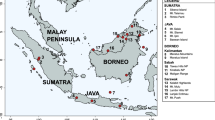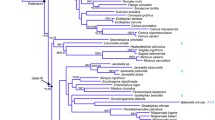Summary
Phylogenetic relationships of the bustard generaOtis, Ardeotis, Afrotis, Chlamydotis, Eupodotis, Lophotis, andTetrax were inferred from nucleotide sequences of the mitochondrial cytochromeb gene (1143 bp).Otis/Chlamydotis, Ardeotis/Eupodotis meppellii, andLophotis/Tetrax cluster as sibling taxa both in MP and ML reconstructions. The genusEupodotis appears to be polyphyletic. In the genusChlamydotis two distinct groups are apparent,C. u. undulata/C. u. fuertaventurae andC. u. macqueenii. In the case of Cm.macqueenii birds from Sinai show a distinct haplotype. Because of substantial genetic, morphological and behavioural differences, it is suggested attributing species rank toC. undulata undC. macqueenii.
Zusammenfassung
Phylogenetische Beziehungen zwischen den TrappengeneraOtis, Ardeotis, Afrotis, Chlamydotis, Eupodotis, Lophotis, undTetrax wurden anhand von Nucleotidsequenzen des mitochondrialen Cytochrom b Gens (1143 Basenpaare) ermittelt. In Maximum Parsimony und Maximum Likelihood Rekonstruktionen clustemOtis/Chlamydotis, Ardeotis/ Eupodotis meppellii, undLophotis/Tetrax als Schwestertaxa. Die GattungEupodotis bildet offenbar eine polyphyletische Gruppe. Innerhalb der GattungChlamydotis lassen sich zwei distinkte Entwicklungslinien erkennen,C. u. undulata/C. u. fuertaventurae undC. u. macqueenii. Innerhalb von Cm.macqueenii weisen die Trappen des Sinai-Gebietes einen eigenen Haplotyp auf. Da sich die beiden Entwicklungslinien durch klare genetische, morphologische und ethologische Merkmale unterscheiden, ware es sinnvoll,C. undulata undC. macqueenii als distinkte Arten zu behandeln.
Similar content being viewed by others
References
Avise, J. C. (1994): Molecular markers, natural history and evolution. London
Avise, J. C. & Zink, R. M. (1988): Molecular genetic divergence between avian sibling species: King and Clapper Rails, Long-billed and short-billed Dowitchers, Boat-tailed and Great-tailed Crackles, and Tufted and Black-crested Titmice. Auk 105: 516–528.
Brown, W. M., George, M. jr. & Wilson, A. C. (1979): Rapid evolution of animal mitochondrial DNA. Proc. Nat. Acad. Sci. U.S.A. 76: 1967–1971.
Brown, W.M., Prager, E.M., Wang, A. & Wilson, A. C. (1982): Mitochondrial DNA sequences of primates: tempo and mode of evolution. J. Mol. Evol. 18:225–239.
Clancey, P. A. (1966): The avian superspecies of the South African fauna. Ostrich Suppl. 6.13–39.
Del Hoyo, J., Elliott, A., & Sargatal, J. (1996): Handbook of the birds of the world. Vol. 3. Barcelona.
Desjardins, P & Morais, R (1990): Sequence and gene organisation of chicken mitochondrial genome. J. Mol. Biol. 212.599–634.
Feduccia, A. (1995): Explosive evolution in tertiary birds and mammals. Science 267: 637–638.
Gaucher, P., Paillat, P., Chappuis, C, Saint Jaime, M., Lotfikah, F. & Wink, M. (1996): Taxonomy of the Houbara BustardChlamydotis undulata subspecies considered on the basis of sexual display and genetic divergence. Ibis 138: 273–283.
Granjon, L., Gaucher, P., Greth, A., Paillat, P. & Vassart, M. (1994): Allozyme study of two subspecies of Houbara bustard. Biochem. Sy st. Ecol. 22: 775–779.
Hedges, S. B., Parker, H. P., Sibley, C. G. & Kumar, S. (1996): Continental breakup and the ordinal diversification of birds and mammals. Nature 381: 226–229.
Hinz, C. & Heiss, E. M. (1989): The activity pattern of Houbara Bustards: Aspects of a field study in the Canary Islands. Bustard Studies 4: 68–79.
Houde, P., Cooper, A., Leslie, E., Strand, A.E. Montano, G. A. (1997): Phylogeny of 12S rDNA in Gruiformes (Aves). In: Mindell, D.P. (Eds.): Avian molecular evolution and systematics. San Diego.
Huelsenbeck, J. P. & Crandall, K. A. (1997): Phylogeny estimation and hypothesis using Maximum Likelihood. Ann. Rev. Ecol. Syst. 28:437–466.
Mindell, D.P. (1997): Avian molecular evolution and systematics. San Diego.
Mourer-Chauviré, C. (1982): Les oiseaux fossiles des Phosphorites du Quercy (éocenè supérieur à oligocène supérieur): implications paléobiogéographiques. Géobios Mémoires Spéciales 6: 413–426.
Olson, S.L. (1985): The fossil records of birds. In: Farner, D. S., King, J. R. & Parkes, K. (Eds.): Avian Biology, vol. 8: 79–238. Orlando.
Pitra, C, Lieckfeldt, D. & Alonso, J. C. (2000): Population subdivision in Europe’s great bustard inferred from mitochondrial and nuclear DNA sequence variation. Mol. Ecology 9: 1165–1170.
Pitra, C, Lieckfeldt, D., Frahnert, S. & Fickel, J. (2002): Phylogenetic relationships and ancestral areas of the bustards (Gruiformes: Otitidae), inferred from mitochondrial DNA and nuclear intron sequences. Mol. Phylogenet. Evol. 23: 63–74.
Sanchez Marco, A. (1989–90): A new bustard (Otididae; Aves) from the early Pliocene of Layna (Soria, Spain). Paleontologia I Evolucio 23: 223–229.
Shields, G.F. & Helm-Bychowsky, K.M. (1988): Mitochondrial DNA in birds. In: Johnston, R. F. (Ed.): Current Ornithology, vol. 5: 273–295. New York.
Shields, G. F. & Wilson, A. C. (1987): Calibration of mitochondrial evolution in geese. J. Mol. Evol. 24:212–217.
Sibley, C.G. & Monroe, B.L. (1990): Distribution and taxonomy of birds of the world. New Haven.
Sibley, G.C. & Ahlquist, J.E. (1990): Phylogeny and classification of birds. A study in molecular evolution. New Haven.
Swofford, D.L. (2002): PAUP-Phylogenetic analysis using parsimony. Version PAUP*4.0bl0.
Swofford, D. L., Olsen, J. G., Waddell, P. J. & Hillis, D. M. (1996): Phylogenetic interference. In: Hillis D. M., Moritz C & Mable B. K. Molecular Systematics. Second edition: 407–514. Sunderland
Tarr, C.L. & Fleischer, R.C. (1993): Mitochondrial DNA variation and evolutionary relationships in the amakihi complex. Auk 110: 825–831.
van Tuinen, M., Sibley, G.C. & Hedges, S.B. (1998): Phylogeny and biogeography of ratite birds inferred from DNA sequences of mitochondrial ribosomal genes. Mol. Bio. Evol. 15: 370–376.
Wilson, A.C., Ochman, H. & Prager, E.M. (1987): Molecular time scale for evolution. Trends Genetics 3: 241–247.
Wink, M. (1998): Application of DNA-Markers to Study the Ecology and Evolution of Raptors. In: Chancellor, R. D., Meyburg, B.-U., Ferrero, J. J. (Eds.): Holarctic Birds of Prey., Adenex WWGBP: 49–71.
Author information
Authors and Affiliations
Rights and permissions
About this article
Cite this article
Broders, O., Osborne, T. & Wink, M. A mtDNA phylogeny of bustards (family Otididae) based on nucleotide sequences of the cytochromeb-gene. J Ornithol 144, 176–185 (2003). https://doi.org/10.1007/BF02465645
Accepted:
Published:
Issue Date:
DOI: https://doi.org/10.1007/BF02465645




